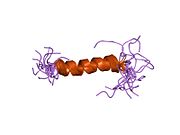Sarcolipin is a micropeptide protein that in humans is encoded by the SLN gene.
Function
Sarcoplasmic reticulum Ca-ATPases are transmembrane proteins that catalyze the ATP-dependent transport of Ca from the cytosol into the lumen of the sarcoplasmic reticulum in muscle cells. The SLN gene encodes a small transmembrane proteolipid that regulates several sarcoplasmic reticulum Ca-ATPases by reducing the accumulation of Ca in the sarcoplasmic reticulum without affecting the rate of ATP hydrolysis.
Ablation of sarcolipin increases atrial Ca transient amplitudes and enhanced atrial contractility. Furthermore, atria from sarcolipin-null mice have blunted response to isoproterenol stimulation, implicating sarcolipin as a mediator of beta-adrenergic responses in atria.
Sarcolipin is an important mediator of muscle based non shivering thermogenesis (NST). It causes the sarcoplasmic reticulum Ca-ATPases to stop pumping Ca ions but continue futilely hydrolysing ATP, thus releasing the energy as heat. Sarcolipin mediated heat production is very important for many organisms to maintain a warm body. In mammals thermogenesis by skeletal muscles is complemented by thermogenesis in the brown adipose tissue and beige adipose tissue. Sarcolipin mediated heat production in contractile muscles helps endothermic fish like the opah heat its body. Some fishes like the billfishes have a specialised brain heater tissue that is derived from muscles that cannot contract but specialise in producing heat using sarcolipin.
Interactions
SLN (gene) has been shown to interact with PLN and ATP2A1.
References
- ^ GRCh38: Ensembl release 89: ENSG00000170290 – Ensembl, May 2017
- "Human PubMed Reference:". National Center for Biotechnology Information, U.S. National Library of Medicine.
- Odermatt A, Taschner PE, Scherer SW, Beatty B, Khanna VK, Cornblath DR, et al. (November 1997). "Characterization of the gene encoding human sarcolipin (SLN), a proteolipid associated with SERCA1: absence of structural mutations in five patients with Brody disease". Genomics. 45 (3): 541–53. doi:10.1006/geno.1997.4967. hdl:2066/25426. PMID 9367679. S2CID 41989102.
- ^ "Entrez Gene: SLN sarcolipin".
- Babu GJ, Bhupathy P, Timofeyev V, Petrashevskaya NN, Reiser PJ, Chiamvimonvat N, Periasamy M (November 2007). "Ablation of sarcolipin enhances sarcoplasmic reticulum calcium transport and atrial contractility". Proceedings of the National Academy of Sciences of the United States of America. 104 (45): 17867–72. Bibcode:2007PNAS..10417867B. doi:10.1073/pnas.0707722104. PMC 2077025. PMID 17971438.
- Bal NC, Periasamy M (March 2020). "Uncoupling of sarcoendoplasmic reticulum calcium ATPase pump activity by sarcolipin as the basis for muscle non-shivering thermogenesis". Philosophical Transactions of the Royal Society of London. Series B, Biological Sciences. 375 (1793): 20190135. doi:10.1098/rstb.2019.0135. PMC 7017432. PMID 31928193.
- Legendre LJ, Davesne D (March 2020). "The evolution of mechanisms involved in vertebrate endothermy". Philosophical Transactions of the Royal Society of London. Series B, Biological Sciences. 375 (1793): 20190136. doi:10.1098/rstb.2019.0136. PMC 7017440. PMID 31928191.
- Reilly SM, Saltiel RA (22 October 2015). "A Futile Approach to Fighting Obesity?". Cell. 163 (3): 539–540. doi:10.1016/j.cell.2015.10.006. PMID 26496598. S2CID 10336243.
- ^ Asahi M, Sugita Y, Kurzydlowski K, De Leon S, Tada M, Toyoshima C, MacLennan DH (April 2003). "Sarcolipin regulates sarco(endo)plasmic reticulum Ca2+-ATPase (SERCA) by binding to transmembrane helices alone or in association with phospholamban". Proceedings of the National Academy of Sciences of the United States of America. 100 (9): 5040–5. Bibcode:2003PNAS..100.5040A. doi:10.1073/pnas.0330962100. PMC 154294. PMID 12692302.
- ^ Asahi M, Kurzydlowski K, Tada M, MacLennan DH (July 2002). "Sarcolipin inhibits polymerization of phospholamban to induce superinhibition of sarco(endo)plasmic reticulum Ca2+-ATPases (SERCAs)". The Journal of Biological Chemistry. 277 (30): 26725–8. doi:10.1074/jbc.C200269200. PMID 12032137.
Further reading
- Lanfranchi G, Muraro T, Caldara F, Pacchioni B, Pallavicini A, Pandolfo D, et al. (January 1996). "Identification of 4370 expressed sequence tags from a 3'-end-specific cDNA library of human skeletal muscle by DNA sequencing and filter hybridization". Genome Research. 6 (1): 35–42. doi:10.1101/gr.6.1.35. PMID 8681137.
- Odermatt A, Becker S, Khanna VK, Kurzydlowski K, Leisner E, Pette D, MacLennan DH (May 1998). "Sarcolipin regulates the activity of SERCA1, the fast-twitch skeletal muscle sarcoplasmic reticulum Ca2+-ATPase". The Journal of Biological Chemistry. 273 (20): 12360–9. doi:10.1074/jbc.273.20.12360. PMID 9575189.
- Smith WS, Broadbridge R, East JM, Lee AG (January 2002). "Sarcolipin uncouples hydrolysis of ATP from accumulation of Ca2+ by the Ca2+-ATPase of skeletal-muscle sarcoplasmic reticulum". The Biochemical Journal. 361 (Pt 2): 277–86. doi:10.1042/0264-6021:3610277. PMC 1222307. PMID 11772399.
- Mascioni A, Karim C, Barany G, Thomas DD, Veglia G (January 2002). "Structure and orientation of sarcolipin in lipid environments". Biochemistry. 41 (2): 475–82. doi:10.1021/bi011243m. PMID 11781085.
- Asahi M, Kurzydlowski K, Tada M, MacLennan DH (July 2002). "Sarcolipin inhibits polymerization of phospholamban to induce superinhibition of sarco(endo)plasmic reticulum Ca2+-ATPases (SERCAs)". The Journal of Biological Chemistry. 277 (30): 26725–8. doi:10.1074/jbc.C200269200. PMID 12032137.
- Minamisawa S, Wang Y, Chen J, Ishikawa Y, Chien KR, Matsuoka R (March 2003). "Atrial chamber-specific expression of sarcolipin is regulated during development and hypertrophic remodeling". The Journal of Biological Chemistry. 278 (11): 9570–5. doi:10.1074/jbc.M213132200. PMID 12645548.
- Asahi M, Sugita Y, Kurzydlowski K, De Leon S, Tada M, Toyoshima C, MacLennan DH (April 2003). "Sarcolipin regulates sarco(endo)plasmic reticulum Ca2+-ATPase (SERCA) by binding to transmembrane helices alone or in association with phospholamban". Proceedings of the National Academy of Sciences of the United States of America. 100 (9): 5040–5. Bibcode:2003PNAS..100.5040A. doi:10.1073/pnas.0330962100. PMC 154294. PMID 12692302.
- Suzuki Y, Yamashita R, Shirota M, Sakakibara Y, Chiba J, Mizushima-Sugano J, et al. (September 2004). "Sequence comparison of human and mouse genes reveals a homologous block structure in the promoter regions". Genome Research. 14 (9): 1711–8. doi:10.1101/gr.2435604. PMC 515316. PMID 15342556.
- Rual JF, Venkatesan K, Hao T, Hirozane-Kishikawa T, Dricot A, Li N, et al. (October 2005). "Towards a proteome-scale map of the human protein-protein interaction network". Nature. 437 (7062): 1173–8. Bibcode:2005Natur.437.1173R. doi:10.1038/nature04209. PMID 16189514. S2CID 4427026.
- Vittorini S, Storti S, Parri MS, Cerillo AG, Clerico A (2007). "SERCA2a, phospholamban, sarcolipin, and ryanodine receptors gene expression in children with congenital heart defects". Molecular Medicine. 13 (1–2): 105–11. doi:10.2119/2006-00054.Vittorini. PMC 1869624. PMID 17515962.
| PDB gallery | |
|---|---|
This article on a gene on human chromosome 11 is a stub. You can help Misplaced Pages by expanding it. |




